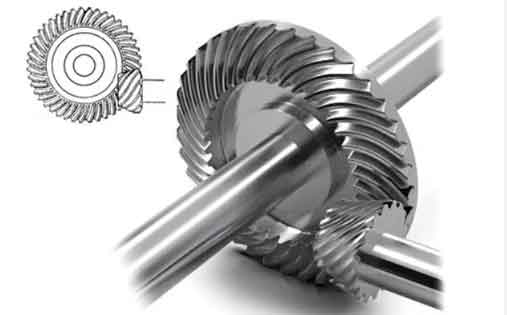This paper proposes an integrated approach combining parametric modeling and multi-objective optimization to enhance the performance of spiral bevel gears. The methodology addresses critical challenges including excessive transmission error, elevated contact temperature, and high Hertzian stress through systematic parameter optimization.

1. Parametric Modeling Framework
The geometric parameters of spiral bevel gears are calculated using fundamental gear design equations:
$$R = \frac{d}{\sin \delta_1} \tag{1}$$
$$d = m \times z \tag{2}$$
$$h_a = (h_{ax} + x)m \tag{3}$$
$$h_f = (h_{ax} + c – x)m \tag{4}$$
$$\theta_a = \arctan\left(\frac{h_a}{R}\right) \tag{5}$$
$$\theta_f = \arctan\left(\frac{h_f}{R}\right) \tag{6}$$
$$\delta_1 = \arctan\left(\frac{z_1}{z_2}\right) \tag{7}$$
$$\delta_2 = 90^\circ – \delta_1 \tag{8}$$
Where \( R \) represents cone distance, \( d \) pitch diameter, and \( \delta \) cone angle. The parametric model enables rapid generation of spiral bevel gear profiles through variable input parameters.
| Parameter | Pinion | Gear |
|---|---|---|
| Number of teeth | 8 | 37 |
| Module (mm) | 8.98 | |
| Pressure angle (°) | 20 | |
| Helix angle (°) | 30 | |
| Cone angle (°) | 12.20 | 77.80 |
2. Multi-Objective Optimization Strategy
The NSGA-II algorithm optimizes three critical design variables:
- Helix angle (\( \beta \))
- Pressure angle (\( \alpha \))
- Face width (\( b \))
Optimization objectives:
$$f_1(\beta, \alpha, b) = \text{Transmission Error (TE)}$$
$$f_2(\beta, \alpha, b) = \frac{1}{\text{Longitudinal Contact Ratio (}\varepsilon_\beta\text{)}}$$
Constrained by:
$$
\begin{cases}
20^\circ \leq \beta \leq 35^\circ \\
15^\circ \leq \alpha \leq 25^\circ \\
70\text{mm} \leq b \leq 75\text{mm}
\end{cases}
$$
| Population Size | 150 |
| Crossover Probability | 0.8 |
| Mutation Probability | 0.2 |
| Maximum Generations | 200 |
3. Optimization Results Analysis
The Pareto frontier reveals optimal compromises between transmission error and contact ratio:
| Parameter | Initial | Optimized | Improvement |
|---|---|---|---|
| Transmission Error (μm) | 6.61 | 3.51 | 46.90% |
| Contact Ratio | 1.46 | 1.78 | 21.92% |
| Hertzian Stress (MPa) | 2,676 | 1,815 | 32.19% |
| Contact Temperature (°C) | 221.8 | 169.3 | 23.69% |
The optimized spiral bevel gear demonstrates:
- Enhanced load distribution through increased contact ratio
- Reduced vibration via minimized transmission error
- Improved thermal management through lower contact temperature
$$ \varepsilon_\beta = \frac{b \sin \beta}{\pi m_n} $$
Where \( m_n \) denotes normal module. The contact ratio improvement directly results from optimized helix angle and face width combination.
4. Critical Parameter Interactions
The non-linear relationships between design variables reveal:
- Helix angle (\( \beta \)) shows quadratic correlation with contact ratio
- Pressure angle (\( \alpha \)) inversely affects Hertzian stress
- Face width (\( b \)) demonstrates linear relationship with bending strength
This multi-objective optimization approach for spiral bevel gears provides designers with a systematic method to balance competing performance requirements. The NSGA-II-based framework enables simultaneous optimization of multiple gear characteristics while maintaining manufacturing feasibility.
